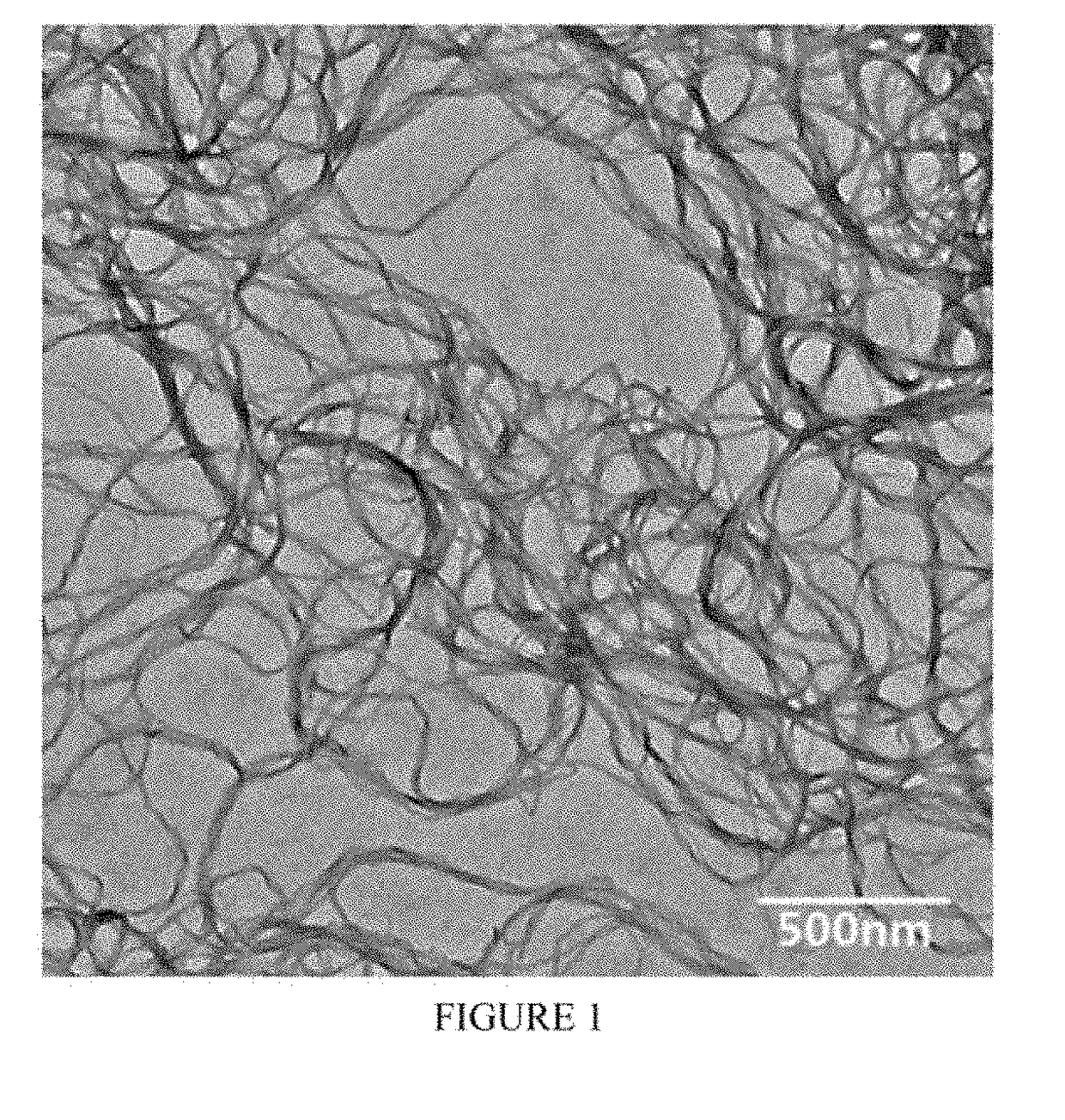Preparation method of para-aramid nanofibers
- Summary
- Abstract
- Description
- Claims
- Application Information
AI Technical Summary
Benefits of technology
Problems solved by technology
Method used
Image
Examples
embodiment 1
[0020]steps: under nitrogen protection, adding 100 mL of a dewatered solvent N-methyl pyrrolidone with moisture content of about 100 ppm into a reaction container; adding 7.5 g of solubilizing salt of CaCl2 and 2 g of surfactant of dimethoxy polyethylene glycol (with a molecular weight of 2000) while stirring; heating to 100° C. to dissolve the solubilizing salt and the surfactant to obtain a solution of the solubilizing salt and the surfactant; cooling the solution to 15° C. in a cold bath, adding 4.326 g of p-phenylenediamine into the reaction container, and cooling the reaction container to 0° C. after the p-phenylenediamine is dissolved; and adding 8.189 g of terephthaloyl chloride, gradually accelerating the stirring speed as 2000 r / m, reacting for 5 min at a reaction temperature below 70° C., continuing to react for 2 min after a gel phenomenon occurs in the reaction system, and stopping stirring, thereby obtaining frozen gel;
[0021]transferring the frozen gel into a tissue dis...
embodiment 2
[0024]steps: under nitrogen protection, adding 100 mL of dewatered solvent of N-methyl pyrrolidone with moisture content of about 120 ppm into a reaction container; adding 6 g of solubilizing salt of LiCl and 1.5 g of surfactant of olyethylene glycol monomethyl ether (with a molecular weight of 2000) while stirring; heating to 80° C. to dissolve the solubilizing salt and the surfactant to obtain a solution of the solubilizing salt and the surfactant; cooling the solution to 10° C. in a cold bath, adding 2.163 g of p-phenylenediamine (PPD) into the reaction container, and cooling the reaction container to −5° C. after the p-phenylenediamine is dissolved; and adding 4.095 g of terephthaloyl chloride (TPC), gradually accelerating the stirring speed as 1500 r / min, stopping stirring after reacting for 30 min to obtain frozen gel, and controlling a reaction temperature to be below 70° C.;
[0025]transferring the frozen gel into a tissue dispersion machine, adding 300 mL of dispersing agent ...
embodiment 3
[0027]steps: under nitrogen protection, adding 100 mL of dewatered solvent of N-methyl pyrrolidone with moisture content of about 120 ppm into a reaction container; adding 8 g of solubilizing salt CaCl2 and 2.5 g of a surfactant amino-terminated polyethylene glycol (with a molecular weight of 2000) while stirring; heating to 90° C. to dissolve the solubilizing salt and the surfactant to obtain a solution of the solubilizing salt and the surfactant; cooling the solution to 10° C. in a cold bath, adding 6.489 g of p-phenylenediamine (PPD) into the reaction container, and cooling the reaction container to −2° C. after the p-phenylenediamine is dissolved; and adding 12.284 g of terephthaloyl chloride (TPC), gradually accelerating the stirring speed to be 1500 r / min, continuously reacting for 4 minutes, controlling a reaction temperature to be below 70° C., and immediately stopping stirring after a gel phenomenon occurs in the reaction system, thereby obtaining frozen gel;
[0028]transferr...
PUM
| Property | Measurement | Unit |
|---|---|---|
| Temperature | aaaaa | aaaaa |
| Temperature | aaaaa | aaaaa |
| Temperature | aaaaa | aaaaa |
Abstract
Description
Claims
Application Information
 Login to View More
Login to View More - R&D
- Intellectual Property
- Life Sciences
- Materials
- Tech Scout
- Unparalleled Data Quality
- Higher Quality Content
- 60% Fewer Hallucinations
Browse by: Latest US Patents, China's latest patents, Technical Efficacy Thesaurus, Application Domain, Technology Topic, Popular Technical Reports.
© 2025 PatSnap. All rights reserved.Legal|Privacy policy|Modern Slavery Act Transparency Statement|Sitemap|About US| Contact US: help@patsnap.com

